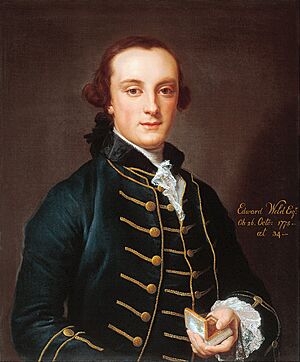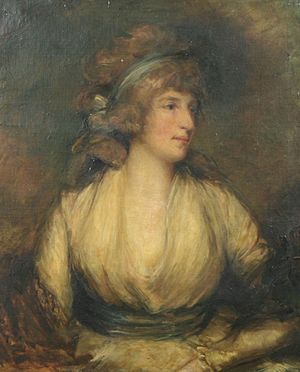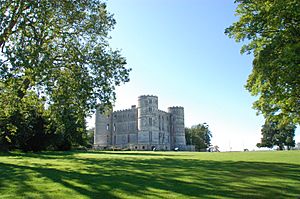Edward Weld facts for kids

Edward Weld (1740–1775) was a very wealthy landowner in Britain. He was part of an important Catholic family during a time when Catholics faced challenges in England.
Contents
Who Was Edward Weld?
Edward Weld was the oldest of four sons and one daughter. His parents were Edward Weld (1705–1761) and Maria Vaughan. Edward inherited a huge amount of land. This included the beautiful Lulworth Estate and its famous Lulworth Castle in Dorset, England. He was one of the richest people in the country.
Edward's Early Life and Education
Like many sons of Catholic families then, Edward and his younger brother, John, went to school abroad. They were sent to Jesuit schools in places like Watten and St Omer. Sadly, their mother died in 1754 while they were away. In 1759, his brother John also passed away.
After finishing his education, Edward traveled around Europe. This was called the "Grand Tour." He learned about manners and visited important places. When he returned to England, his father had also died. Edward was now very rich and ready to find a wife.
Marriages and Death
In 1763, Edward married Juliana Petre. She was the daughter of Robert James Petre, 8th Baron Petre. Sadly, Juliana died in 1772.
In 1775, Edward married Maria Smythe. She was 16 years younger than him and did not have much money. Just three months after their wedding, Edward had a terrible accident. He fell off his horse and died from his injuries. He didn't have time to sign a new will.
Edward did not have any children from either marriage. So, his large estate went to his younger brother, Thomas.
Maria's Later Life
Edward's widow, Maria, was left without much money. She soon married Thomas Fitzherbert. He also died a few years later in 1781. But he left her well-off. She became known as "Mrs Fitzherbert" in history. Later, in 1785, she secretly married the Prince of Wales. He later became King George IV.
Edward's Widow and the Weld Family

Edward's widow, Maria, stayed connected to the Weld family. She became good friends with Lord William Stourton. He was related to her and also to the Weld family through marriage. Maria trusted William a lot. She even asked him to help manage her business and be in charge of her will.
William Stourton also wrote down Maria's memories. These notes are very important. They tell us about her marriage to the future King George IV. Maria did not talk about whether she had children with the King. This was a very sensitive topic because it could affect who would become king or queen next.
Later, Edward's nephew-in-law, Cardinal Weld, helped Maria. He convinced Pope Pius VII that her marriage to George was valid in the eyes of the Church.
Weld Family Landholdings
Here are some of the main lands Edward Weld owned in 1775:
- Lulworth, Dorset
- Lulworth Cove, Dorset
- Lulworth Castle, Dorset
- Holne, Devon
- Ilfracombe, Devon
- Compton Bassett, Wiltshire
- Boldre, Hampshire
- Chilworth, Hampshire
- Winkton, Hampshire
- Britwell, Oxfordshire
- Toddington, Bedfordshire
- Leagram, Lancashire
- Stonyhurst, Lancashire
- Aston, Staffordshire
- Pipe Ridware, Staffordshire
Later, in 1801, Edward's brother Thomas bought Pylewell Park in Hampshire. He gave it as a wedding gift to his son, Joseph. In 1837, Joseph's second son, also named Thomas, inherited Ince Blundell Hall in Merseyside.


